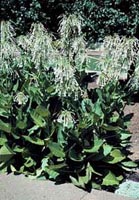Resource Library
Plant of the Week: Tobacco, Ornamental
The University of Arkansas System Division of Agriculture does not promote, support or recommend plants featured in "Plant of the Week." Please consult your local Extension office for plants suitable for your region.
Plant of the Week
Ornamental Tobacco
Latin: Nicotiana sylvestris

Growing tobacco in the garden is certainly nothing new. In fact, it has been going on for centuries but of course for an entirely different purpose. Tobacco was one of the New World’s first exports, and the leaves of this clammy weed have caused ongoing turmoil in societies wherever it was introduced.
The ornamental tobaccos, and there are perhaps half a dozen that have been grown as such, have a strong family resemblance to the N. tabacum used in cigarettes, but their leaves lack the nicotine content to make them suitable for smoking.
Nicotiana sylvestris is the most spectacular of the flowering tobaccos because it has the large bold leaves of the cultivated tobacco on plants that reach 5 feet tall. The masses of trumpet shaped tubular flowers are snow white in color, 3 inches long and borne in drooping panicles at the top of the plant. While there is a hint of sweet fragrance, this species lacks the aroma of it’s common multi-colored cousin N. alata, the flowering tobacco.
Tobacco belongs to the potato family and, as such, is related to the tomato, pepper and deadly nightshade. The early explorers and conquistadors encountered natives smoking the leaf. Cortez shipped leaf back to Spain in 1519. The genus Nicotiana, named after Jean Nicot who was a French Counsel to Portugal and responsible for introducing tobacco seeds into Europe in 1560, consists of 70 species scattered throughout the Americas and into Polynesia and Australia. Sir Walter Raleigh, the explorer who first surveyed the coast from Florida to the Carolinas and named the land Virginia, introduced tobacco to England in 1586 and popularized its use in Europe.
Attacks on smoking began soon after the leaf made landfall in Europe. Pope Urban VIII banned the use of snuff during church services about 1600 and the Sultan of Turkey prohibited smoking on pain of death if caught. In 1604, England’s James I wrote a manifesto against what he considered a loathsome and dangerous habit. Some speculate that James I’s order beheading Raleigh in 1618 may have been because the King really had a thing against smokers.
But the addictive traits of tobacco are hard to resist. Tobacco farming began in the West Indies in 1535 and in Virginia in 1586. By 1640, 7,000 shops in London were selling nothing but tobacco, and tobacco leaf was the major source of currency during much of this nations earliest years. While the multi-billion dollar tobacco law suits may prove the most effective means of suppressing cigarette consumption so far, it’s probably too early to say that the smoking public is ready to switch away from their addiction of choice.
But we stray from the point. N. sylvestris was introduced from Argentina in 1899 and has been grown occasionally since then as a component of the Victorian flower garden or, more recently, as a background plant in the mixed border. While few nurseries carry this annual as a bedding plant, seeds are available from some of the seed houses such as Thompson and Morgan which offer wide assortments.
Ornamental tobacco is best seeded inside about eight weeks before the expected last frost free date. It should be set out in early spring as a rosette of green leaves, not grown so long that the stem begins to stretch out.
While you want to avoid late season frosts, this plant should be planted as early in the season as possible. Plants do best in a bright location but preferably with some late afternoon shade. It needs a good fertile soil and frequent watering to do its best.
By: Gerald Klingaman, retired
Extension Horticulturist - Ornamentals
Extension News - August 3, 2001
The University of Arkansas System Division of Agriculture does not maintain lists of retail outlets where these plants can be purchased. Please check your local nursery or other retail outlets to ask about the availability of these plants for your growing area.